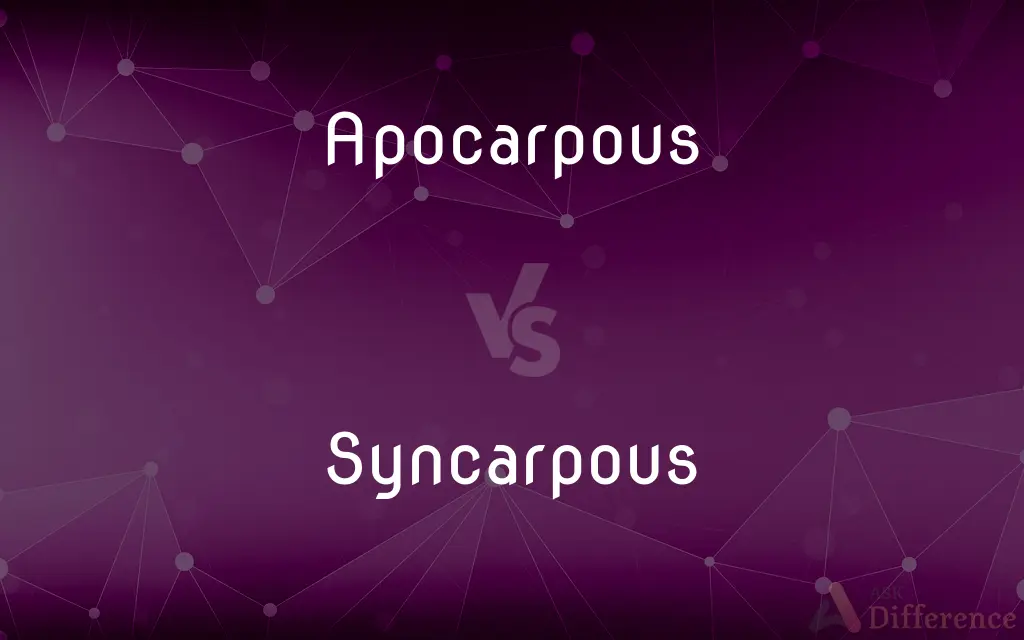Apocarpous vs. Syncarpous — What's the Difference?
Edited by Tayyaba Rehman — By Fiza Rafique — Updated on April 16, 2024
Apocarpous flowers have separate carpels, allowing for independent development; syncarpous flowers feature fused carpels, forming a single compound ovary.

Difference Between Apocarpous and Syncarpous
Table of Contents
ADVERTISEMENT
Key Differences
In apocarpous flowers, each carpel remains distinct and independent, which can lead to multiple ovaries within a single flower. This structural feature affects both the flower's form and its reproductive processes. On the other hand, syncarpous flowers have their carpels united, typically resulting in a single ovary. This fusion can influence the flower's pollination strategy and seed dispersal mechanisms.
Apocarpous plants, such as those in the Ranunculaceae family, display a greater flexibility in their reproductive strategies, allowing for adaptation to various pollinators. Whereas syncarpous plants, like those in the Fabaceae family, might attract specific types of pollinators due to their structured and often intricate flower forms.
The separate carpels in apocarpous flowers can lead to the development of fruits that are either free-standing or loosely connected, giving rise to various fruit types. Conversely, syncarpous flowers usually develop a single fruit from the compound ovary, which may be advantageous for efficient seed dispersal.
From an evolutionary perspective, apocarpous flowers represent a more primitive condition, potentially offering multiple reproductive outcomes. On the other hand, syncarpous flowers are seen as an evolutionary advancement that optimizes reproductive success in specific ecological niches.
In horticulture and agriculture, the distinction between apocarpous and syncarpous flowers influences breeding and cultivation practices. Plants with apocarpous flowers might be bred for traits like fruit variability, while those with syncarpous flowers are often selected for uniformity and yield.
ADVERTISEMENT
Comparison Chart
Ovary Structure
Separate, independent carpels
Fused carpels into a single ovary
Evolutionary Stage
Considered more primitive
Considered more advanced
Fruit Development
Multiple or separate fruits
Single, compound fruit
Pollination Strategy
Flexible, adapts to various pollinators
Structured, attracts specific pollinators
Example Plants
Ranunculaceae (e.g., buttercups)
Fabaceae (e.g., peas)
Compare with Definitions
Apocarpous
Considered an evolutionary primitive trait.
Many early-diverging flowering plants are apocarpous.
Syncarpous
Syncarpous flowers have fused carpels forming one ovary.
In tomatoes, the fused carpels form a large, single fruit.
Apocarpous
Adaptation to various pollinators is a key feature.
Apocarpous plants often exhibit a wide range of flower forms.
Syncarpous
Typically results in a single compound fruit.
Syncarpous flowers of citrus yield segmented fruits.
Apocarpous
This characteristic allows for independent fruit development.
The apocarpous nature of magnolias results in multiple fruit types.
Syncarpous
Attracts specific pollinators due to structured flowers.
The intricate flowers of orchids are syncarpous.
Apocarpous
Apocarpous flowers feature separate carpels.
In buttercups, each carpel can develop into a separate fruit.
Syncarpous
Seen as an evolutionary advancement.
Most modern flowering plants exhibit syncarpy.
Apocarpous
Can result in a variety of reproductive strategies.
Apocarpous flowers adapt their reproduction to different ecological conditions.
Syncarpous
Focused on optimizing reproductive success in certain environments.
Syncarpous plants often dominate specific ecological niches.
Apocarpous
Having carpels that are free from one another. Used of a single flower with two or more separate pistils, as in roses.
Syncarpous
Having or consisting of united carpels. Used of a pistil.
Apocarpous
(botany) Having carpels that are not joined
Syncarpous
Having carpels joined together
Apocarpous
Either entirely or partially separate, as the carpels of a compound pistil; - opposed to syncarpous.
Syncarpous
Composed of several carpels consolidated into one ovary.
Apocarpous
(of ovaries of flowering plants) consisting of carpels that are free from one another as in buttercups or roses
Syncarpous
(of ovaries of flowering plants) consisting of united carpels
Common Curiosities
What defines an apocarpous flower?
An apocarpous flower is characterized by having separate, independent carpels.
What are the reproductive benefits of apocarpous flowers?
They offer flexibility in reproductive strategies, adapting to various pollinators and environments.
Why are syncarpous flowers considered evolutionarily advanced?
They optimize reproductive processes and structures for specific ecological roles.
How does the structure of carpels affect fruit type?
Separate carpels in apocarpous flowers allow for diverse fruit types, whereas fused carpels in syncarpous flowers usually lead to a single fruit type.
Are apocarpous flowers more common in certain habitats?
They are often found in diverse ecological settings where flexible reproductive strategies are advantageous.
Can the structure of a flower's carpels influence its pollination strategy?
Yes, apocarpous flowers can attract a diverse range of pollinators, whereas syncarpous flowers tend to attract specific types, tailored to their structured form.
How do syncarpous flowers differ from apocarpous in terms of fruit development?
Syncarpous flowers generally produce a single, compound fruit, while apocarpous flowers may produce multiple or separate fruits.
How does the evolutionary stage of a flower impact its cultivation?
Plants with more primitive (apocarpous) or advanced (syncarpous) floral structures may require different breeding strategies for cultivation.
What ecological advantages do syncarpous flowers have?
They can be more efficient in seed dispersal and attracting specific pollinators, which may benefit survival in competitive environments.
What is an example of a syncarpous plant and its fruit?
The tomato is an example, producing a large, single fruit from its fused carpels.
Are there specific plant families known for having apocarpous flowers?
Yes, families like Ranunculaceae are known for their apocarpous floral structure.
What role does flower structure play in attracting pollinators?
Flower structure, whether apocarpous or syncarpous, significantly influences the type and behavior of pollinators it attracts.
How might climate change affect apocarpous versus syncarpous plants?
Climate change could shift pollinator populations and behaviors, impacting the reproductive success of both types of plants differently.
Share Your Discovery

Previous Comparison
Eat vs. Pat
Next Comparison
Totally vs. CompletelyAuthor Spotlight
Written by
Fiza RafiqueFiza Rafique is a skilled content writer at AskDifference.com, where she meticulously refines and enhances written pieces. Drawing from her vast editorial expertise, Fiza ensures clarity, accuracy, and precision in every article. Passionate about language, she continually seeks to elevate the quality of content for readers worldwide.
Edited by
Tayyaba RehmanTayyaba Rehman is a distinguished writer, currently serving as a primary contributor to askdifference.com. As a researcher in semantics and etymology, Tayyaba's passion for the complexity of languages and their distinctions has found a perfect home on the platform. Tayyaba delves into the intricacies of language, distinguishing between commonly confused words and phrases, thereby providing clarity for readers worldwide.














































